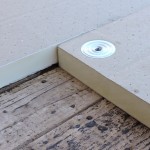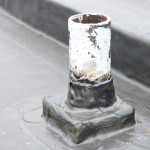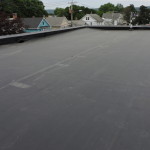Consider for a moment the flat black rubber roof. Technically an Ethylene Propylene Diene Monomer (EPDM) roof, for most of us the first image they conjure up is the roof on your high school or a local shopping mall. You’ll probably recall those flat or sloped roofs would typically be covered in a black, gooey substance and topped off with what looked like small stones or gravel poured on top, right?
Not exactly a thing of beauty. We have to agree that they can and sometimes do look pretty bad. Which is why, despite their intrinsic value in providing significant levels of insulation and their relatively low cost for materials, installation and maintenance, EPDM roofs, as Rodney Dangerfield would say, don’t get any respect.
 Here at Connecticut Roofcrafters, we find flat and sloped roofs constructed with EPDM to be a fantastic roofing solution for the right buildings. What’s more, we have found over the years that if you plan your roof properly, prepare the surface carefully prior to installation and put a little bit extra effort into roof trims, not only will you have a superb, hard-wearing new roof but one that will actually look nice too.
Here at Connecticut Roofcrafters, we find flat and sloped roofs constructed with EPDM to be a fantastic roofing solution for the right buildings. What’s more, we have found over the years that if you plan your roof properly, prepare the surface carefully prior to installation and put a little bit extra effort into roof trims, not only will you have a superb, hard-wearing new roof but one that will actually look nice too.
To this end, we recently completed a new EPDM flat roof to complement an architectural shingle installation we were doing at the Hamden Plains Methodist Church in Hamden, CT. The architectural shingles we installed were to replace an aging slate roof over the main sanctuary. The EPDM roof covered an attached services building which also provided access to the roof. This meant creating drainage for a variety of seams, angles as well as the access port.
One of the big advantages to rubber is the price. Although a homeowner generally must use a licensed installer to lay down this roof, the cost of the entire job still favorably compares to the cost for other types of roofing. Not only is the roofing material itself less expensive than most other choices, but the product is also lightweight, and installation is fast and easy, reducing labor and installation costs.
Additionally, EPDM roofs are also extremely energy efficient. An EPDM roof reflects the sun’s heat,  especially the lighter-colored roofs designed for residential use, saving the homeowner considerably on air conditioning costs. EPDM and the accompanying underlayment also insulates the home, trapping in heat to reduce energy costs and utility bills in the colder months. The homeowner does not have to worry about the rubber freezing or cracking under extremes of cold weather. Modern EPDM roofing is designed to take both extremes of cold as well as heat.
especially the lighter-colored roofs designed for residential use, saving the homeowner considerably on air conditioning costs. EPDM and the accompanying underlayment also insulates the home, trapping in heat to reduce energy costs and utility bills in the colder months. The homeowner does not have to worry about the rubber freezing or cracking under extremes of cold weather. Modern EPDM roofing is designed to take both extremes of cold as well as heat.
The key first step, as with any worthwhile project, is preparation. We remove all the existing roof materials and adhesives and then inspect, repair or replace any underlying sheathing. Once the underlayment is shaped up, you could place the EPDM down but we strongly encourage applying a layer of insulation, which serves two functions. First, it keeps heat in and cold out but it also serves as a platform for the EMPD to sit upon. This enhances the aesthetics of your roof but it also, and more importantly, provides a platform to shape the roof and account for any irregularities. It lets us properly plane drainage, drip edges and any other design elements which will channel water from the roof, for example. For the Hamden Plains Methodist Church, we used rigid foam panels as an insulation layer.
 Upon completion of the insulation layer, we then dry-fit the EMPD, taking drains, vents and other roof elements into account prior to gluing into place. We then lay down additional material in places of suspected wear or where the shape of the roof requires a unique application. The EPDM with work with is very flexible as well as durable; one of the great things about modern rubber is that it is not susceptible to the sun’s UV and ultraviolet rays. A properly-installed rubber roof can last 50 years or even longer. Moreover, rubber can withstand high winds and even hail up to three inches in diameter.
Upon completion of the insulation layer, we then dry-fit the EMPD, taking drains, vents and other roof elements into account prior to gluing into place. We then lay down additional material in places of suspected wear or where the shape of the roof requires a unique application. The EPDM with work with is very flexible as well as durable; one of the great things about modern rubber is that it is not susceptible to the sun’s UV and ultraviolet rays. A properly-installed rubber roof can last 50 years or even longer. Moreover, rubber can withstand high winds and even hail up to three inches in diameter.
Another big advantage of rubber is that should the roof ever develop a leak from unexpected events (kids retrieving frisbees or, back in the early 80s, lawn darts!), repairs are fast, easy and extremely inexpensive. In many cases a tube of liquid rubber is all that is needed; in other cases a special tape designed specifically for repairing rubber will do the job. While on the topic of unfortunate events, rubber is also fire resistant. EPDM roofs are almost impossible to set afire, even with a lightning strike, additionally the rubber is fire resistant and can slow a fire to provide time for help to arrive. To this end, some homeowner’s insurers will provide a rate reduction for installing an EPDM roof.
Maintenance is another advantage. Almost all roofing materials require some maintenance over the years, but rubber requires little if any care. Obviously, any seasonal accumulation of foliage which might interfere with drainage must be addressed but in general, the most that a homeowner may wish to do is to repaint the roof with acrylic paint once every 10 to 12 years. Additionally, rubber is one of the greenest choices that a homeowner can make. The rubber itself takes less energy to produce than most other roofing materials and is often made from recycled materials to begin with. Further, the roof is 100% recyclable at the end of its long life.
years, but rubber requires little if any care. Obviously, any seasonal accumulation of foliage which might interfere with drainage must be addressed but in general, the most that a homeowner may wish to do is to repaint the roof with acrylic paint once every 10 to 12 years. Additionally, rubber is one of the greenest choices that a homeowner can make. The rubber itself takes less energy to produce than most other roofing materials and is often made from recycled materials to begin with. Further, the roof is 100% recyclable at the end of its long life.
In closing, we find that for all the value an EPDM roof delivers, they can actually look pretty darn nice as well. While we know that beauty is in the eye of the beholder, it can also appear in your wallet or pocketbook.
To learn more about our EPDM roofs, contact us via email or toll-free on 1-888-612-0798
